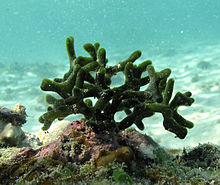Codium
| Codium | |
|---|---|

| |
| Codium spongiosum off the Reunion Islands coast | |
| Scientific classification | |
| Clade: | Viridiplantae |
| Division: | Chlorophyta |
| Class: | UTC clade |
| Order: | Bryopsidales |
| Family: | Codiaceae |
| Genus: | Codium Stackhouse, 1797 |
| Type species | |
| Codium tomentosum Stackhouse, 1797
| |
| Species | |
|
See text | |

Codium is a genus of seaweed in the Chlorophyta of the order Bryopsidales. Paul Silva was an expert on the genus Codium taxonomy at the University of California at Berkeley. There are about 50 species worldwide.[1]
Description
The genus has thalli of two forms, either erect or prostrate. The erect plants are dichotomously branched to 40 centimetres (16 in) long with branches forming a compact spongy structure, not calcareous. The final branches form a surface layer of close palisade cortex of utricles. The non-erect species form either a prostrate or globular thallus with a velvet-like surface, the final branches forming a close cortex of utricles.[2]
Distribution
Ireland
Two of these species are very rare in Ireland. Codium adhaerens has been recorded from a few sites on the west coast and from Tory Island on the north coast in County Donegal. In 1837 it was found in Church Bay in County Antrim,[3] but has not been found there since.
- Codium adhaerens C.Agardh
- Codium bursa (Linnaeus) C.Agardh - has been found in Mulroy Bay in County Donegal in 1977 (specimen in the Ulster Museum) and 1988. There is an old record of it from "near Belfast" between 1793 and 1810.
- Codium fragile (Suringar) Hariot
- Codium tomentosum Stackhouse
- Codium vermilara (Olivi) Delle Chiaje
There are other species of "doubtful validity":- Codium amphibium is included in William Henry Harvey's Phycologia Britannica Pl.xxxv. and noted as: "spreading in patches of great extent along the edge of the sea, over the surface of a turf-bog which meets the shore at Roundstone Bay" (Ireland).
Worldwide
- Codium arabicum Kütz. - Australia
- Codium arenicola Chacana & P.C.Silva - Australia
- Codium australasicum P.C.Silva - Australia
- Codium bulbopilum Setch. - Australia
- Codium capitulatum P.C.Silva & Womersley - Australia
- Codium convolutum (Dellow) P.C.Silva - New Zealand
- Codium cuneatum S. & G. - California (United States)
- Codium duthiae Silva - Australia, Tasmania, and South Africa
- Codium dwarkense Børgesen - Australia
- Codium extricatum Silva - Cape Agulhas to southern KwaZulu-Natal
- Codium fragile (Suringar) Hariot - Nova Scotia (Canada)
- Codium fragile Sui song - (Chinese)[4] Japan, American Pacific from Alaska to Cape Horn, Australia and New Zealand, British Isles, Norway, Denmark, and Netherlands
- Codium fragile subsp. capense Silva - South Africa
- Codium galeatum J.Agardh - Australia
- Codium geppiorum O.C.Schmidt - Australia and Indo-Pacific South Africa
- Codium harveyi P.C.Silva - Australia
- Codium hubbsii Daws. - California (U.S.A.)
- Codium intertextum Collins & Hervey
- Codium isthmocladum Vickers
- Codium johnstonei Silva - California (U.S.A.)
- Codium laminarioides Harv. - Australia
- Codium lucasii Setchell - Australia, Tasmania
- Codium mamillosum Harv. - Australia
- Codium muelleri Kütz. - Australia
- Codium perriniae A.H.S.Lucas - Australia
- Codium pomoides J.Agardh - Australia
- Codium setchellii Gardn. - California (U.S.A.)
- Codium silvae Womersley - Australia
- Codium spinescens P.C.Silva & Womersley - Australia
- Codium spongiosum Harv. - Australia
- Codium strangulatum Chacana & P.C.Silva - Australia
- Codium taylorii Silva - Australia
- Codium repens (P.Crouan & H.Crouan) Vickers
- Codium tenue (Kütz.) Kütz. - Australia
- Codium tomentosum Stackh. - Australia
References
- ^ C. van den Hoek; D. G. Mann; M. H. Jahns (1995). Algae: An Introduction to Phycology. Cambridge: Cambridge University Press. ISBN 978-0-521-30419-1.
- ^ E. M. Burrows (1991). Seaweeds of the British Isles. Volume 2. Chlorophyta. London: Natural History Museum. ISBN 978-0-565-00981-6.
- ^ Morton,O. 1994. Marine Algae of Northern Ireland. Ulster Museum. ISBN 0 900761 28 8
- ^ Abbott, Isabella A. (1989). Lembi, Carole A.; Waaland, J. Robert (eds.). Algae and human affairs. Cambridge University Press, Phycological Society of America. p. 141. ISBN 978-0-521-32115-0. Food and food products from seaweeds
General references
- Guiry, M.D.; Guiry, G.M. (2007). "Genus: Codium taxonomy browser". Galway: AlgaeBase version 4.2 World-wide electronic publication, National University of Ireland. Retrieved 2007-09-24.
- G. Hardy; M. D. Guiry (2006). A Check-list and Atlas of the Seaweeds of Britain and Ireland (PDF). London: British Phycological Society. ISBN 978-3-906166-35-3. Archived from the original (PDF) on 2011-07-25. Retrieved 2007-06-29.
- O. Morton (1978). "Some interesting records of algae from Ireland". Irish Naturalists' Journal. 19: 140–242.
- O. Morton (1994). Marine Algae of Northern Ireland. Belfast: Ulster Museum. ISBN 978-0-900761-28-7.
- O. Morton (2003). "The marine macroalgae of County Donegal, Ireland". Bulletin of the Irish Biogeographical Society. 27: 3–164.
- Hilda M. Parkes (1975). "Records of Codium species in Ireland". Proceedings of the Royal Irish Academy. 75 (B): 123–134.
- P. C. Silva (1955). "The dichotomous species of Codium in Britain" (PDF). Journal of the Marine Biological Association of the United Kingdom. 24 (3): 565–577. doi:10.1017/S0025315400008821.
- P. C. Silva; D. E. G. Irvine (1960). "Codium amphibium: a species of doubtful validity" (PDF). Journal of the Marine Biological Association of the United Kingdom. 39 (3): 631–636. doi:10.1017/S002531540001359X.
External links
- F. G. Hardy; I. Tittley. "Codium fragile". Marine advice: non-native species. Joint Nature Conservation Committee. Archived from the original on 2007-09-30. Retrieved 2007-06-29.
- M. D. Guiry (2006-11-11). "Codium fragile (Suringar) Hariot". AlgaeBase.
- M. D. Guiry (2007-02-22). "Codium fragile ssp. tomentosoides (van Goor) P.C. Silva". AlgaeBase.
